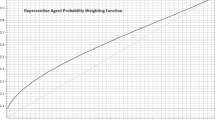Abstract
Experimental investigations of non-expected utility have primarily concentrated on decision under risk (“probability triangles”). The literature suggests, however, that ambiguity is one of the main causes for deviations from expected utility (EU). This article investigates the descriptive performance of rank-dependent utility (RDU) in the context of choice under ambiguity. We use the axiomatic difference between RDU and EU to critically test RDU against EU. Surprisingly, the RDU model does not provide any descriptive improvement over EU. Our data suggest other “framing” factors that do provide descriptive improvements over EU.
Similar content being viewed by others
References
Camerer, C.F. (1989). “An Experimental Test of Several Generalized Utility Theories,” Journal of Risk and Uncertainty 2, 61–104.
Camerer, C.F., and T.-H., Ho. (1994). “Violations of the Betweenness Axiom and Nonlinearity in Probability,” Journal of Risk and Uncertainty 8, 167–196.
Camerer, C.F., and M., Weber. (1992). “Recent Developments in Modelling Preferences: Uncertainty and Ambiguity,” Journal of Risk and Uncertainty 5, 325–370.
Fishburn, P.C. and P.P., Wakker. (1995). “The Invention of the Independence Condition,” Management Science 41, 1130–1144.
Hey, J.D., and C., Orme. (1994). “Investigating Parsimonious Generalizations of Expected Utility Theory Using Experimental Data,” Econometrica 62, 1291–1326.
Kahneman, D., and A., Tversky. (1979). “Prospect Theory: An Analysis of Decision under Risk,” Econometrica 47, 263–291.
Li, S. (1994). “What is the Role of Transparency in Cancellation?” Organizational Behavior and Human Decision Processes 60, 353–366.
Lopes, L.L. (1987). “Between Hope and Fear: The Psychology of Risk,” Advances in Experimental Psychology 20, 255–295.
Savage, L.J. (1954). The Foundations of Statistics, New York: Wiley; 2nd ed. (1972), New York: Dover.
Schmeidler, D. (1989) “Subjective Probability and Expected Utility without Additivity,” Econometrica 57, 571–587.
Starmer, C. and R., Sugden (1989). “Probability and Juxtaposition Effects: An Experimental Investigation of the Common Ratio Effect,” Journal of Risk and Uncertainty 2, 140–151.
Starmer, C. and R., Sugden. (1991). “Does the Random-Lottery Incentive System Elicit True Preferences? An Experimental Investigation,” American Economic Review 81, 971–978.
Tversky, A. and C., Fox. (1995). “Weighing Risk and Uncertainty,” Psychological Review 102, 269–283.
Tversky, A. and D., Kahneman. (1986). “Rational Choice and the Framing of Decision,” Journal of Business 59, pt. 2, 251–278.
Tversky, A. and D., Kahneman. (1992). “Advances in Prospect Theory: Cumulative Representation of Uncertainty,” Journal of Risk and Uncertainty 5, 297–323.
Tversky, A. and D., Koehler. (1994). “Support Theory: A Nonextensional Representation of Subjective Probability,” Psychological Review 101, 547–567.
Tversky, A. and P.P., Wakker. (1995). “Risk Attitudes and Decision Weights,” Econometrica 63, 1255–1280.
Wakker, P.P. (1996). “The Sure-Thing Principle and the Comonotonic Sure-Thing Principle: An Axiomatic Analysis,” Journal of Mathemetical Economics 25, 213–227.
Wakker, P.P., I., Erev, and E., Weber. (1994). “Comonotonic Independence: The Critical Test between Classical and Rank-Dependent Utility Theories,” Journal of Risk and Uncertainty 9, 195–230.
Weber, E.U. (1994). “From Subjective Probabilities to Decision Weights: The Effects of Asymmetric Loss Functions on the Evaluation of Uncertain Outcomes and Events,” Psychological Bulletin 115, 228–242.
Weber, E.U. and B., Kirsner. (1995). Reasons for Rank-Dependent Utility Evaluation. New York: Center for Decision Research.
Wu, G. and R. Gonzalez. (1994). “Curvature of the Probability Weighting Function,” Management Science, forthcoming.
Wu, G. (1994). “An Empirical test of Ordinal Independence,” Journal of Risk and Uncertainty 9, 39–60.
Author information
Authors and Affiliations
Rights and permissions
About this article
Cite this article
Fennema, H., Wakker, P. A test of rank-dependent utility in the context of ambiguity. J Risk Uncertainty 13, 19–35 (1996). https://doi.org/10.1007/BF00055336
Issue Date:
DOI: https://doi.org/10.1007/BF00055336




